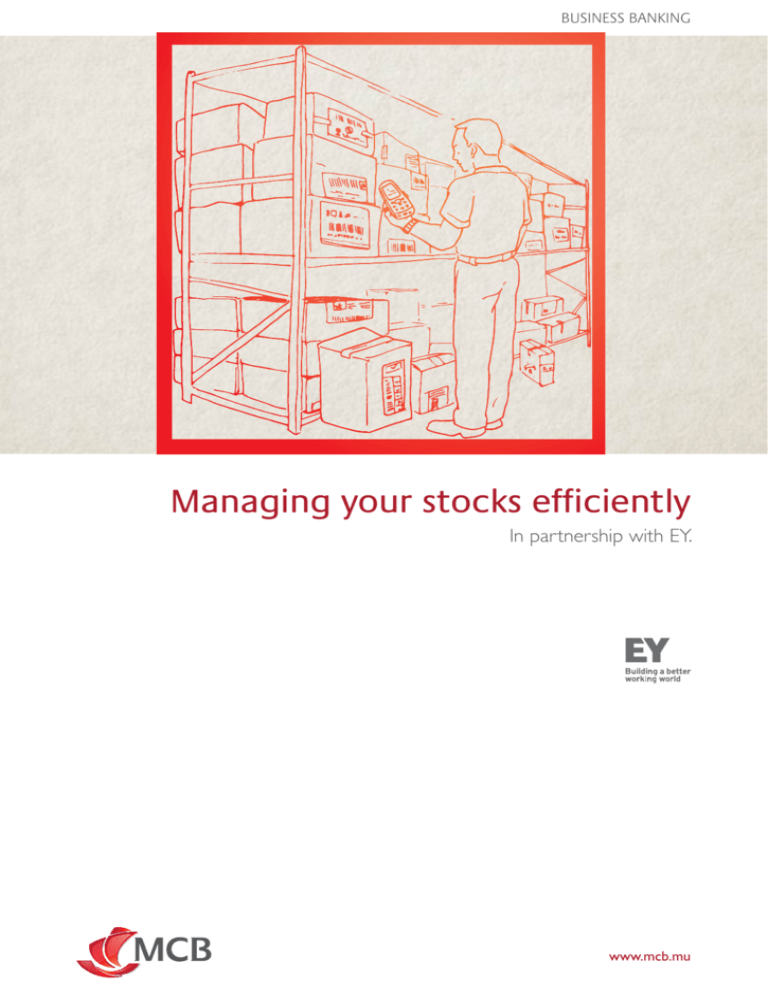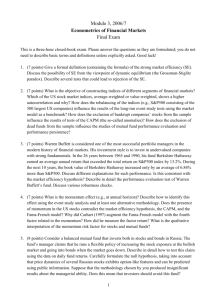Stock efficiencyPDF 667KB
advertisement

BUSINESS BANKING Managing your stocks efficiently In partnership with EY. www.mcb.mu Managing your stocks efficiently Ideally, a business holds sufficient goods to cater for the market demand. There are both advantages and disadvantages for the different methods in the management of stocks. • The right quantity Those responsible for the management of stock perpetually search for the right balance between the level of consumer satisfaction and the costs associated with the storage of goods. An excessive amount of stocks (over-storage) implies substantial financial charges: - Fixed charges (buildings, shelves, handling of engines, etc.) - Variable charges (salaries, costs of recruitment and electricity, losses due to deterioration or obsolescence of products stored). -This can also lead to disorganisations within the whole system of production (bottlenecks, increase in storage intermediaries). -Similarly, a low quantity of stock increases the risk of shortages, often leading the business to severe financial consequences like the decrease in sales benefits and loss of a customer due to late deliveries. • The different stock management methods Effective stock management is based on two fundamental parameters: - date of the order - quantity ordered An entrepreneur must decide on the most suitable method of stock management according to the product sold and its level of demand. 1. Provision of stock in time and fixed quantities The calendar method is mostly used for annual delivery contracts with suppliers. Equal quantities of raw materials or goods are delivered to the Stock Manager at fixed dates. This method is generally adapted to products whose consumption is regular. Advantages: This method makes the management of stocks simpler, usually allowing the business to negotiate with the suppliers due to the large quantities ordered. Disadvantages: If the refill quantity is wrongly calculated or if the consumption of the good is not regular, there is a risk of accumulated stock (which would have financial costs) or of a shortage of stock. In case of a shortage, urgent deliveries outside the framework of the contract may be very costly for the business (air freights etc). 2. Provision of stock at variable time and fixed quantities The method known as control point consists of establishing a minimum quantity of stock which allows the business to order fixed quantities of the good (economic lot), as well as cover their needs during late deliveries. This method is usually applied to expensive products whereby the consumption is less regular. The economic lot is a fixed quantity of a good which the Stock Manager orders when in need for stock. This specific quantity is established using “Wilson’s Formula”, whereby the business can minimise total inventory holding costs and ordering costs. Advantages: Economic lot orders allow business to make better use of their stock. Moreover, accurate calculations of stock can help avoid treasury needs. Disadvantages: If the consumption of the good undergoes a sudden and irregular growth, there is a high risk of shortage. Businesses can maintain a safety pile of stock for such circumstances, but again, it has financial consequences. 3. Provision of stock at fixed times and varying quantities The replenishment method is used for goods that are expensive, perishable, or bulky, and the consumption is regular. For each product ordered, a maximum quantity is first established. During a fixed period of time, the Stock Manager analyses its current stock and orders enough just to reach the maximum quantity allowed. Advantages: This method makes it easier for the business to manage its stocks and handle the costs. Disadvantages: In case of an irregular consumption of the good, there is a high risk of an excess or shortage of stock. 4. Provision of stock on demand and varying quantities This method is used for stocks used in projects, whereby orders are only placed when needed. In other words, the stocks ordered are an estimation of short term needs. Advantages: The business can limit any unnecessary stock. Disadvantages: This method is vulnerable to the external environment, notably the economy. For example, a minor incident can have major consequences on the running of the project. The delays in delivery may lead to the eventual loss of a customer. Our Knowledge Centre helps you grow business ideas. More business tips are available from our suite of practical guides. Visit us on www.mcb.mu/knowledge-centre The present Guideline is strictly confidential and designed solely for your personal use. MCB does not warrant for the correctness and accuracy of the information herein contained which is provided for indicative purposes only. MCB shall not, in any circumstance whatsoever, bear responsibility or be held liable for any error, or omission, or any loss which may arise as a result of your reliance upon the present Guideline. Published in August 2013.







